Argyll Project Visits
Our new Project Coordinator, Louis MacMillan, spent a great week in Argyll catching up with several HIEF – supported projects. Here’s his write up of the trip:
On the Isle of Arran, I met with COAST – a community-led marine-conservation charity that successfully led the proposal for Scotland’s first ‘No Take Zone’ in Lamlash Bay. It was fantastic to meet Áine Purcell-Milton and Jenny Crockett at the Discovery Centre, which acts as an immersive visitor experience and central hub for activities such as snorkelling and Citizen Science trips on their research vessel RV COAST Explorer. Their engagement with young people is particularly inspiring; they offer boat trips to every primary school child on the island, and are extending such opportunities to mainland communities across the Firth of Clyde. Their future strategy for youth engagement, to address problems such as depopulation, is currently being drafted with consultants after receiving part-funding from HIEF. Crucially, this £14 000 grant led on to a successful National Lottery Heritage Fund bid, and the ‘Youth Action Plan’ now sits within a wider project called ‘Now you SEA it’. This encompasses future infrastructural development, an ‘Investing in Volunteers’ programme, and many other exciting plans.
In Mid Argyll, it was a pleasure to catch up with some of the Seawilding team. Their Seagrass and Oyster Restoration provide beacons of hope in the murky waters of marine management – the majority of MPA’s continue to be unprotected from damaging scallop dredging and bottom-trawling despite their ‘protected’ designation. The marine restoration that Seawilding are pioneering faces challenges such as limited oyster availability (due to disease in the main UK hatchery) and low seagrass survival rates post-planting. However, progress is being made in a variety of areas, particularly research, where discoveries are informing restoration projects around the globe. The HIEF-funded Seagrass nursery, for example, compared germination rates in different conditions; revealing optimum planting techniques, substrate composition, and seawater concentration, which saved years of trial and error on the seabed.
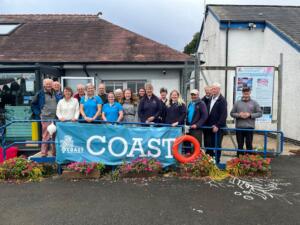

The COAST team, pictured at the Discovery Centre in Lamlash Bay (left), and the Seawilding Seagrass Nursery by Loch Craignish (right).
While in Mid Argyll, I also caught up with Pete Creech from Heart of Argyll Wildlife, in their beautiful Beaver Visitor Centre in Knapdale. Their exciting Water Vole Reintroduction project has grown to incorporate a mink-eradication programme which is just getting underway. The damage to voles and ground nesting birds caused by invasive American mink in Knapdale requires a phased landscape-scale approach, which will be led by Heart of Argyll Wildlife in partnership with other local land-management stakeholders. When the programme reaches a stage where it is feasible to reintroduce water voles, they will thrive in the wetland habitats created by beavers, building on the successes of their pioneering reintroduction to Knapdale 15 years ago.
Later on I visited John Aitchison from Friends of the Sound of Jura, who has led the Sea Lice Mapping and Modelling projects over the last three years. The resources that they have produced present a visual assessment of sea lice densities, due to fish farm distribution, across the whole of the West Coast of Scotland. This means that the cumulative impact of sea lice on migrating wild fish can be estimated, resulting in better-informed decision making for new fish farm applications. For example, the Kilbrannan Sound fish farm received planning permission on the strict condition that it contains no fish during the May of the second year of production, when sea lice densities are highest. Simultaneously, the Mapping and Modelling resources have been made available to community groups through the Coastal Communities Network, providing the means to oppose inappropriate fish farm applications in their local area.
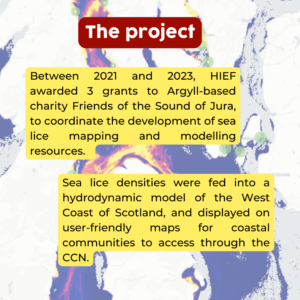
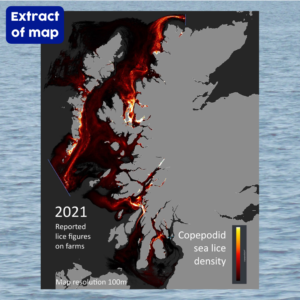
A summary of the Sea Lice Modelling and Mapping project – click here for more info.
In Oban, local charity Keep Oban Beautiful are leading a ‘Waterfall Wood Rehabilitation’ project with a team of dedicated volunteers. In the centre of town, right by Oban High School, a disused area of woodland is being transformed into a healthy ecosystem for the benefit of plants, animals, and humans. It was a pleasure to be shown around the magical wood by volunteer Laura Corbe from Keep Oban Beautiful, and see the real difference made by volunteer work parties over the winter and spring. What was initially home to a carpet of litter and a tangled mass of invasive rhododendron is now a green, lush, and accessible example of rare temperate rainforest. Through the HIEF grant, the team plan to continue invasive non-native species removal, and increase accessibility through a small area of boardwalk and the creation of a pond/wetland area. Perhaps most excitingly, however, are the opportunities that this project will create for high-school children, through partnerships with various classes (such as art), to increase awareness and understanding of these globally rare and significant habitats.


Summaries of Oban Waterfall Wood Rehabilitation project – more here.
Just up the road at the Scottish Association for Marine Science (SAMS), I met Dr Alex Thomson and Dr Matt Davey to find out more about their ongoing Red Snow Algae project. Scotland’s summer snow patches have long been celebrated and monitored, yet little is known about the rare species of algae that live in this harsh habitat, tinging the surface red and earning the nickname ‘watermelon snow’. The researchers at SAMS are perfectly placed to lead the first research into Scotland’s red snow algae, having studied the phenomenon in Antarctica, and partnered with the Culture Collection of Algae and Protozoa (CCAP) – the world’s most diverse collection of live algal strains whose facilities are on-site at SAMS. Seeing this state-of-the-art collection at Dunstaffnage, along with the Scottish snow algae samples, was a mesmerizing experience. Through the microscope, the algal cells are arranged into stunning formations; a visual reminder of the complexity and diversity of more-than-human life. Along with analysis and biobanking of these samples, the team are also working to increase awareness of red snow in Scotland, and earlier in the summer published a popular science article on UK Hillwalking.

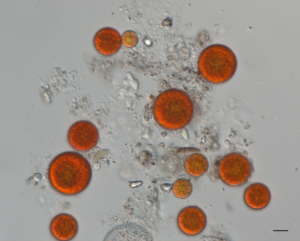
Red algae on a Scottish snow patch (left), and under the microscope (right).
My Argyll trip culminated with a weekend on Mull, visiting the Hebridean Whale and Dolphin Trust (HWDT) on Saturday followed by Ardura Community Forest on Sunday.
The HWDT open day was a great opportunity to meet so many of the team, and learn all about whale, dolphin and porpoise conservation on the West Coast of Scotland. I joined a wildlife watching session at Tobermory lighthouse, and stepped onboard their beautiful research vessel, Silurian, in the harbour. Their Minke Whale project, analysing thirty-years of photographic data, is just a strand of their wider work that includes advocacy, research and education. The open day culminated in with ‘Fins and Gins’ – an evening of talks celebrating 30 years since HWDT was established. Speakers highlighted the historical relationship between human and whale communities on the West Coast, from the early whaling industry to modern day citizen science, the latter facilitated largely by their Whale Track app. Finally, it was heart-breaking to learn about the West Coast Killer Whales – whose drawn-out extinction reminds us of the importance of effective marine protection and conservation.
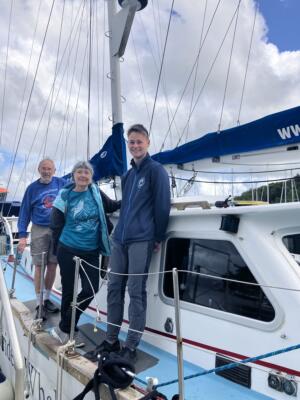
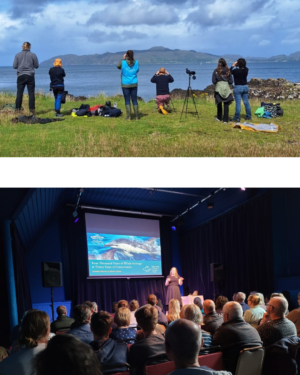
Visiting the Hebridean Whale and Dolphin Trust on Silurian (left), at Tobermory lighthouse (top right), and at their evening Fins and Gins event (bottom right – images on right by HWDT).
The following day I headed down past Craignure to visit a volunteer work party at Ardura Forest – a community woodland owned and managed by the Mull and Iona Community Trust (MICT). Their Biodiversity Action Plan set out methods to protect and restore biodiversity over a 20-year period, and the initial phase of this plan is now being carried out. The twin threats of invasive non-native species (INNS) and deer overgrazing have prevented natural regeneration to occur, but INNS removal and tree shelter creation are being carried out to address this. Aside from these HIEF-funded projects, a forest shelter, composting toilet, and picnic benches have been constructed with larch harvested onsite, facilitating access to the forest for the community. It was a pleasure to walk through the woodland with Rachel French, Ardura Biodiversity Officer, and Moray Finch, MICT General Manager. The riparian native oaks, by the swirling River Lussa, is an enchanting place which I would highly recommend visiting.
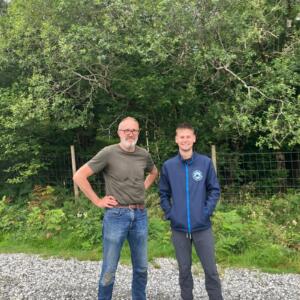
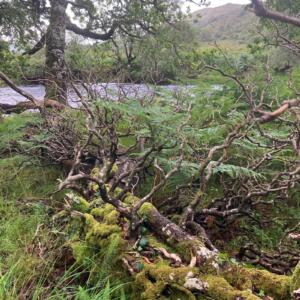
Meeting up with Moray Finch from MICT (left) in the beautiful oak woodland at Ardura (right).
